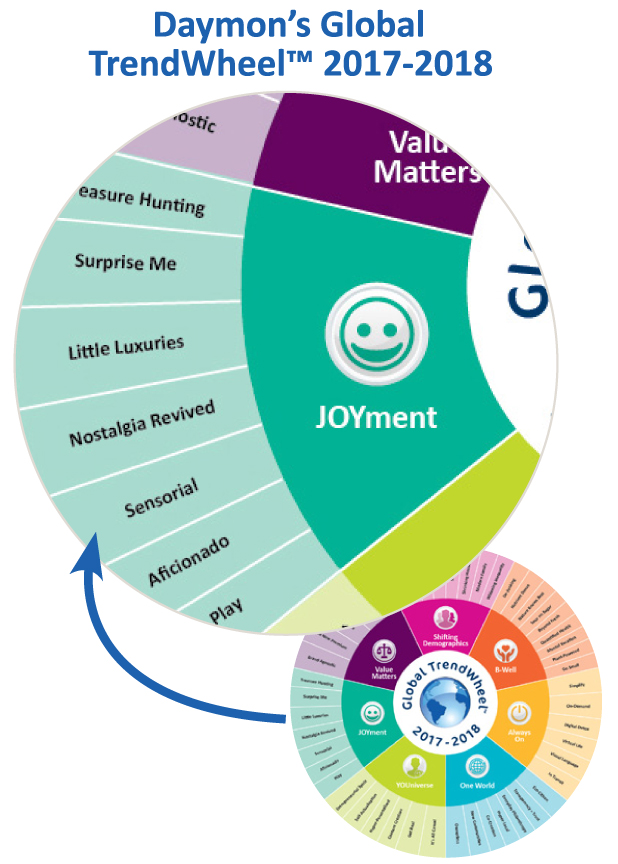Engaging Consumers through Surprise and Delight
Retail is moving beyond transaction to interaction. The store of the future is not just about products on the shelf, but linking relevant offerings with memorable experiences. A recent study by consulting firm Deloitte found that among 200 retailers in the United States, those that offered both a differentiated assortment and experiential elements saw the highest five-year earnings growth. This is the driving force behind what the Thought Leadership Team at Daymon calls the “JOYment” trend.
JOYment is all about finding new and innovative ways to surprise and delight consumers—delivering on their demand for products, services and experiences that provide a temporary relief from the pressures of daily living. It’s one of the seven key mega trends that make up Daymon’s Global TrendWheel™, a proprietary “futures” forecasting tool that identifies, defines and tracks the evolution of global consumer behavior.
To help guide its partners on how to deliver on JOYment, Daymon brings dimension to the trend with targeted themes ranging from sensorial experiences, to encouraging nostalgia and play, to catering to aspiring aficionados.
According to Nicole Peranick, Director of Culinary Thought Leadership for Daymon,
“these themes are applicable across all industries, classes of trade, categories and retail services—from product development to in-store merchandising and execution.” In addition, there’s a spectrum of ways retailers and brands can implement them, says Dave Harvey, Vice President of Thought Leadership for Daymon.
One of the most immediate ways to capitalize on the JOYment trend is by creating experiences for shoppers that help them engage with products and brands through multiple senses. This can be as simple as in-store food sampling events like those featured at American grocery retailer Trader Joe’s. Or they can be highly executed experiences, like British cosmetics retailer Molton Brown’s interactive mirror, where animation and sound effects virtually transport shoppers to the exotic locations where ingredients are sourced.
 “At a time when brick-and-mortar retailers are facing increasing competition from e-commerce, sensorial experiences are one of the key ways to highlight the in-store advantage,” says Carl Jorgensen, Director of Wellness Thought Leadership for Daymon.
“At a time when brick-and-mortar retailers are facing increasing competition from e-commerce, sensorial experiences are one of the key ways to highlight the in-store advantage,” says Carl Jorgensen, Director of Wellness Thought Leadership for Daymon.
For brick-and-mortar and e-commerce retailers alike, playing to consumers’ sense of nostalgia is another way to bring joy and delight. Consumers appreciate references to memories of times past communicated through products, packaging, flavors, décor and music. New applications include nostalgic flavors repurposed with a modern twist—like Malt Shop Cookies™ made with the almost “forgotten” flavor of malted milk—as well as throwback versions of toys and games, like a remake of the classic Nintendo gaming system in a mini version, a top seller from this past holiday season.
In a similar vein, consumers are rediscovering the kid in themselves through products and services that inspire play. The appeal of this trend can be seen through the growth of adult coloring books, augmented reality games like Pokémon GO, and “gamified” foods, like British retailer Tesco’s Croquette Roulette assortment (where the flavor you get is determined by the flick of a game board spinner).
But it’s not all play and no work for today’s consumers. There are many aspiring aficionados actively seeking out deep subject matter expertise in everything from music to coffee to craft beer. In response, retailers and brands are beginning to offer unique products and services that cater to niche markets. For example, global coffee chain Starbucks recently announced plans to expand its Reserve Roastery concept through the U.S., Shanghai, Tokyo and Europe. These unique venues will offer coffee tastings, education by expert roasters and baristas, and exclusive ultra-premium blends.
Whether making tweaks to existing products and services or developing entirely new ones, retailers and brands should be assured that their efforts to surprise and delight consumers will be well worth it. “This trend definitely has some legs to it,” says Jorgensen. “There are many successful examples of exciting retail experiences in the marketplace, and it’s continuing to grow. Retailers should feel confident committing resources to making shopping fun and engaging.”
For questions about retail trends identified by Daymon and the four forces reshaping retail, contact Dave Harvey, Daymon Vice President of Thought Leadership at dharvey@daymon.com.

